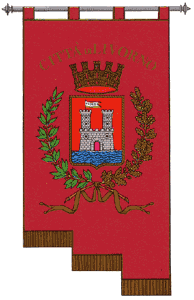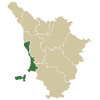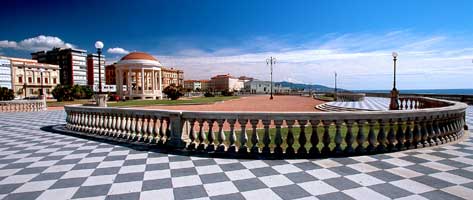|  Inhabitants in 1991: 167.512 Inhabitants in 1991: 167.512
 Starting
10 kilometres south of the mouth of the Arno, the municipal territory
extends for 104,78 square kilometres on the low but rocky Tyrrhenian
coast opposite the rocks of Meloria. Comprising a narrow stretch
of plain, the rise of the Livorno and Montenero mountains and the island
of Gorgona. Capital of the captaincy, it became autonomous community
in 1780 assuming the borders of the original nucleus of the old captaincy. Starting
10 kilometres south of the mouth of the Arno, the municipal territory
extends for 104,78 square kilometres on the low but rocky Tyrrhenian
coast opposite the rocks of Meloria. Comprising a narrow stretch
of plain, the rise of the Livorno and Montenero mountains and the island
of Gorgona. Capital of the captaincy, it became autonomous community
in 1780 assuming the borders of the original nucleus of the old captaincy.
The territory on which Livorno had its origins was dominated in the
entire course of the Medieval period by the presence of the urban
and economic centre represented by Pisa and by its port. In documents
from the XII century Livorno appears in effect as an inhabited
offshoot of the Pisa Port, a place inhabited by fishermen and peasants
placed at the southern extreme of the sinus pisanus, the great arc of
Stagno which extended as far as Pisa. Grown in the course of the XIII
century and object of costly and prolonged improvement works
which culminated at the end of the century with the realisation of the
encircling walls, Livorno was part of the Pisa dominion until 1405.
Passed to Geneva in 1421 and sold by them for 100,000 florins to
the republic of Firenze. Object of continual attempts to conquer
it by the French, Spanish and the Milan Duchy, at war with Firenze,
it did not have, despite political exemptions and privileges, a
satisfying growth until the XVI century. Between 1519 and 1533,
to improve the equipment and the safety, they constructed the Vecchia
Fortezza designed by Antonio da Sangallo il Vecchio, which was isolated
and completely surrounded by water. But the intervention of major
importance for Livorno was initiated by Costimo I and was the enlarging
of the port with a new quay ,they built public warehouses and
connected it, with the canal of Navicelli, to Pisa, where
it gave a new thrust to the activity of the arsenal. Other privileges
and exemptions enticed numerous Italian and foreign merchants, above
all Jewish, who contributed to the formation of the cosmopolitan
identity. The successors of Cosimo continued the fortification works,
stimulating the public building trade and not abandoning the political
privileges: in 1606 the surroundings were extended, then named
new captaincy, and Livorno obtained the title of city, while in
1676 it was transformed in free port. Its development, witnessed by the
demographic growth which was clearly defined from the end of the
1500s, continued until the second half of the XVIII century, thanks
also the abolition of the customs tax by Leopoldo I di Lorena. Damaged
by the continental embargo during the Napoleonic domination (1799-1815),
it returned with vigour, even augmenting the population, under Leopoldo
II with whom it returned to being a free port and re-strengthened its
ties with its economic background. It actively participated in the revival
movement and in 1849 was occupied by the Austrian army.
From 1870 it was the centre of a strong popular workers movement
organised in association and league category, which after having made
an action of opposition to the war of 1015-18, promoted the occupation
of the factories and in 1919 was instrumental in getting a socialist
majority in the city government. In 1921 it held a congress
there which brought about the socialist split and led to the constitution
of the Italian Communist Party. Around the 1920s the first Fascist
combat arose at Livorno against which in 1922 the antifascist action
squads were formed the “Arditi del popolo” . Becoming
clandestine after the special law of 1926, the antifascist movement was
strengthened during the second world war and the intense propaganda activity
in the factories and among the military, several of whom subsequently
entered in the partisan formations of the province. Strategic and military
objective, Livorno was massively bombarded by the Anglo-Americans and
almost totally destroyed. Occupied from September 1943 by the Germans,
it was liberated in July 1944 by the American Fifth Army preceded
by the III brigade of Garibaldi Val di Cecina. Among its most illustrious
sons are the writer and politician Francesco Domenico Guerrazzi
(1804-1873), the artists Giovanni Fattori (1825-1908) and Amedeo
Modigliani (1884-1920), the musician Pietro Mascagni (1864-1945
and the poet Giorgio Caproni (1912-1990).
 At the beginning of the 16th century Livorno was just a small
fishing village and would probably have stayed that way if the Medici
family hadn't decided to provide Tuscany with an efficient port.
Livorno was chosen on the basis of the area's geographical characteristics:
it was near the mouth of the Arno but on the edge of the alluvial
plain, and it was situated on a rocky but low-lying coast which made it
easier to build the port complex. The Porto Mediceo and the large-scale
fortifications of the city were built between 1518 and 1618 according
to a pentagonal plan drawn up by Buontalenti. The act of foundation
of the city on 10 June 1593 was strikingly original: the constitution
of Livorno gave anyone who wanted to live in Livorno the right to do so
for a period of 25 years. Jewish refugees, French Huguenots, English Catholics,
Muslims, and so on flocked here, and Livorno became a cosmopolitan
and liberal city. Due to the sharp rise in population in the 18th
century, the city expanded considerably with the construction of other
quarters. Further modifications were necessary in the 19th century with
the building of the railway station.
Besides its port and shipyards, the economic resources of the city
also include industry, especially petrochemicals. After the port, industrial
zone, and a large part of the city were destroyed by bombing in the last
war, everything was rebuilt but the industrial zone was moved to
the north-east of the city, encroaching on the territory of Pisa and Pontedera.
Livorno is the largest port in Tuscany and one of the most
important in the Mediterranean. It consists of two complexes,
the Porto Vecchio and the Porto Nuovo (Porto Industriale). However, the
most interesting part of the city from an artistic point
of view is the historic city centre. The Fortezza Vecchia is today
the most important monument in the city, and includes the 9th century
Torre Matilde and the 14th century Quadratura dei Pisani.
Built on the orders of Ferdinand II, the neighbourhood of Venezia
Nuova is laced with canals similar to those found in Venice. Following
the course of the Fosso Reale, you come to the synagogue and the
Museo Ebraico.
The city's urban layout was reorganised under the Austrian Grand
Dukes. Walking along the beautiful Passegiata (grand boulevard) you come
to the Terrazza Mascagni, and then from the Bagni Scoglio to the Bagni
Pancaldi-Acquaviva. It's worth seeing the new site of the Museo Giovanni
Fattori at Villa Milibelli, which was built in 1865 by the wealthy
merchant Francesco Milibelli. Also worth a visit is the tasteful Mercato
delle Vettovaglie, which was built in 1894 by the architect Badaloni.
The most significant gastronomic speciality of Livorno is cacciucco,
a word of Balkan origins which means 'mix'. This extremely tasty dish
contains a wide variety of fish, and although it's a 'poor man's dish',
it is very imaginative and strong-tasting. It's one of the most well-known
of all Tuscan dishes.
Places to visit:
The New Venice, 1600s quarter
adjacent to the old village grooved by canals (hence its name)
Fortezza Vecchia, imposing fortified complex from 1518 designed
by Antonio da Sangallo il Vecchio on the orders of Giulio de’
Medici (Pope Clemente VII). It was subsequently enlarged and modified.
In 1769 Pietro Leopoldo di Lorena instituted a military college for
Nobles there.
Porto Mediceo, completed in 1620 by Cosimo
II. In the immediate neighbourhood is the 1300 Torre del Fanale erected
on the ruins of Lazzaretto of 1528.
Monumento a Ferdinando
I, (called also Quattro Mori) particular monument realised by
two artists in different periods.
Fortezza Nuova, surrounded
by the Royal Channel it was built around 1592 projected by Buontalenti
Civic Museum Giovanni Fattori, organised since 1994 in the
Villa Mimbelli, the museum collects works of 1800 and early 1900 together
with a collection of Macchiaioli paintings.
Cisternone,
work (as is the Costernino ) by Pasquale Poccianti from 1828; elegant
water tank for the city’s water
Cathedral, named
for S. Francesco d’Assisi, faces onto the Piazza Grande. The
construction of the end of the 1500s was almost totally destroyed
by the bombardments of the last war. Reconstructed following the original
lines it has a simple grey marble façade preceded by a portico.
The luminous single nave interior preserves precious works of art.
Nuova Sinagoga, was reconstructed after the war on the place
of the preceding synagogue of 1600s. its interior is enriched with
works of art. |
Historical info reproduced upon authorization of
Regione Toscana - Dipartimento della Presidenza E Affari Legislativi e
Giuridici
Picture by Sandro Santioli
Translated by Ann Mountford
|